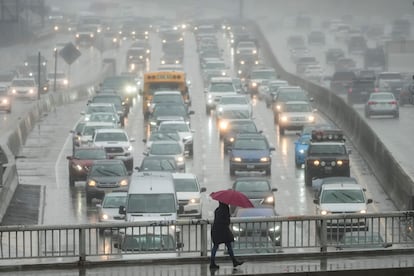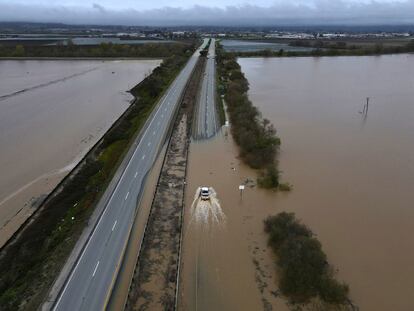Atmospheric river: What is it and how will it impact California
This atmospheric phenomenon provides beneficial rain or snow in certain areas, but it also could be devastating

An atmospheric river is very different from other rivers. It is not found on land flowing into an ocean, sea, bay, lake or other body of water. Unlike them, these are miles up in the air, floating in the air, being carried by the wind. But how does a river float? The answer lies in the state of the water, which is not liquid, but vapor, being able to travel from one place to another along with the air currents.
This atmospheric phenomenon is common in the United States, particularly on the West Coast, and also in the Iberian peninsula, western Europe, the west coast of North Africa and in Iran, where a rare atmospheric river was singled out as responsible for the March 2019 floods that resulted in more than 70 deaths.
Here we explain in detail what an atmospheric river is, its origin and the dangers it can present.
What is an atmospheric river?
Atmospheric rivers are narrow, relatively long regions found in the atmosphere that transport much of the water vapor out of the tropics, as explained by the US Department of Commerce’s National Oceanic and Atmospheric Administration (NOAA), which also describes them as “rivers in the sky” due to their visual appearance. They can also be described as a column or filament of concentrated moisture (hydrosphere) in the atmosphere.
These rivers, which can come in different sizes and shapes, are columns of vapor that move with the weather, and carry an amount of water vapor roughly equivalent to the flow of water at the mouth of the Mississippi River. When they reach Earth, they usually release this vapor in the form of water or snow depending on weather conditions. Their average size is between 400 and 600 km (250 to 372 miles).
About 30% to 50% of annual precipitation on the West Coast of the United States occurs through some atmospheric rivers, which are considered a primary feature in the global water cycle and are linked to water supplies and flood risks in the western United States.

Are atmospheric rivers dangerous?
Most atmospheric rivers are “weak” systems that provide beneficial rain or snow for the area. However, some of the larger and stronger rivers can disrupt travel or cause various damages, such as landslides, property damage or even deaths.
Atmospheric rivers are divided into five categories, with the first being Weak, whose impact is beneficial. The second is Moderate and is also beneficial but with a risk of damage. The third one, Strong, has equal benefit and danger. The fourth, Extreme, is mainly hazardous but also beneficial. And the fifth one, Exceptional, is primarily hazardous.
An example of a category five atmospheric river was the one that caused a historic 100-hour storm (from December 29, 1996 to January 2, 1997), which resulted in over $1 billion in damage to southeastern Oregon, northern California, and western Nevada.
Atmospheric rivers could become increasingly dangerous due to climate change. Rising temperatures (which are expected to rise even more) evaporate more water from the ocean, which can hold 7% more water vapor for each additional degree of temperature. In a few years, atmospheric rivers could become larger, and more dangerous.
The Pineapple Express
Pineapple Express is a term used to describe a recurring atmospheric river that is associated with heavy precipitation in the waters northeast of Hawaii, extending northeastward toward the Pacific coast of North America. This is one of the most common examples of an atmospheric river.
Many Pineapple Express phenomena occur simultaneously with large arctic troughs in the northwestern United States, often resulting in major melt flooding with warm, tropical rains falling on the frozen, snow-laden ground. Throughout US history, different Pineapple Express have had strong impacts on California or its west coast. In 2022 and 2023, several floods in the California Bay Area were attributed to a Pineapple Express. On March 10, 2023, California Governor Gavin Newsom declared an emergency in 21 counties and requested a presidential declaration of emergency to authorize federal aid due to the risk of atmospheric river flooding.
Sign up for our weekly newsletter to get more English-language news coverage from EL PAÍS USA Edition
Tu suscripción se está usando en otro dispositivo
¿Quieres añadir otro usuario a tu suscripción?
Si continúas leyendo en este dispositivo, no se podrá leer en el otro.
FlechaTu suscripción se está usando en otro dispositivo y solo puedes acceder a EL PAÍS desde un dispositivo a la vez.
Si quieres compartir tu cuenta, cambia tu suscripción a la modalidad Premium, así podrás añadir otro usuario. Cada uno accederá con su propia cuenta de email, lo que os permitirá personalizar vuestra experiencia en EL PAÍS.
¿Tienes una suscripción de empresa? Accede aquí para contratar más cuentas.
En el caso de no saber quién está usando tu cuenta, te recomendamos cambiar tu contraseña aquí.
Si decides continuar compartiendo tu cuenta, este mensaje se mostrará en tu dispositivo y en el de la otra persona que está usando tu cuenta de forma indefinida, afectando a tu experiencia de lectura. Puedes consultar aquí los términos y condiciones de la suscripción digital.
More information
Archived In
Últimas noticias
Most viewed
- Reinhard Genzel, Nobel laureate in physics: ‘One-minute videos will never give you the truth’
- Oona Chaplin: ‘I told James Cameron that I was living in a treehouse and starting a permaculture project with a friend’
- Pablo Escobar’s hippos: A serious environmental problem, 40 years on
- Why we lost the habit of sleeping in two segments and how that changed our sense of time
- The fall of a prolific science journal exposes the billion-dollar profits of scientific publishing










































